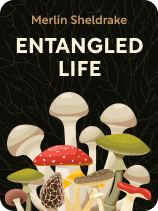

This article is an excerpt from the Shortform book guide to "Entangled Life" by Merlin Sheldrake. Shortform has the world's best summaries and analyses of books you should be reading.
Like this article? Sign up for a free trial here.
What are the best quotes from Entangled Life? What do these quotes say about the purpose of fungi?
In Entangled Life, Merlin Sheldrake offers his research on fungi to prove that they’re far more useful and intelligent than we ever thought. He challenges your ideas of fungi with scientific evidence proving how complex these microorganisms are.
Keep reading for Entangled Life quotes that represent Sheldrake’s findings.
The Best Entangled Life Quotes to Remember
After publishing Entangled Life in 2020, biologist Merlin Sheldrake made a meal out of two copies of the book. He dampened the pages of the first copy, inoculated it with fungal spores, and feasted on the mushrooms that burst from its pages. He then macerated the pages of the second copy and fermented them into a beer he drank.
Sheldrake’s process of transforming these copies of his book embodies the themes he explores throughout its chapters. He examines what we know and don’t yet know about fungi, these mysterious organisms that transform their surroundings—and us. He argues that fungi are an understudied group of organisms that expand our imaginations and offer promising solutions to modern-day problems such as mental illness and environmental destruction. Below we present four Entangled Life quotes that embody Sheldrake’s insights on fungal biology and why fungi matter.
“Some fungi have tens of thousands of mating types, approximately equivalent to our sexes (the record holder is the split gill fungus, Schizophyllum commune, which has more than twenty-three thousand mating types, each of which is sexually compatible with nearly every one of the others). The mycelium of many fungi can fuse with other mycelial networks if they are genetically similar enough, even if they aren’t sexually compatible. Fungal self-identity matters, but it is not always a binary world. Self can shade off into otherness gradually.”
All life forms reproduce by replicating their DNA and passing it to the next generation. Fungi is no different:
Step 1: Attraction. According to Sheldrake, fungi release sex pheromones (a chemical signal) to attract mates. (Shortform note: According to other researchers, fungal sex pheromones don’t only attract mates. These sex pheromones can also induce the creation of fungal sex organs—specialized hyphae that produce gametes (the equivalent of sperm and eggs).)
Step 2: Sex. After attraction, two fungi start having sex when a hypha from one mycelium fuses with the hypha of another. Their genetic material meets and combines in this fused channel. (Shortform note: We usually think of sex as something that happens between genetically different individuals. For a long time, scientists thought this was the only way organisms produced offspring with new genetic material. However, researchers recently discovered that this isn’t the only way of producing new genetic material: Some fungi clone themselves, have sex with their clones, and still manage to create new genetic material for their offspring.)
Step 3: Spore dispersal. After sex, one of the fungi grows flesh that develops into spores—cells containing the new genetic material. Then, this fungus disperses those spores. Although not all fungi use mushrooms for this step, Sheldrake focuses on describing several of the ways mushrooms spread spores:
- Explosive ejection: Some mushrooms eject spores into the air at high speeds. (Shortform note: Many of these mushrooms are able to achieve high speeds because they use fluid-filled tubes that shoot out spores, like a water gun.)
- Animal consumption: When animals eat mushrooms, they deposit the spores within their feces in a new location. (Shortform note: Conservation biologists sometimes measure spore levels in animal feces to predict the distribution of hard-to-find fungi.)
- Invasion: Some fungi invade organisms’ bodies. For example, Ophiocordyceps—the “zombie ant fungus”—infects an ant, manipulates its behavior so it crawls to an elevated location, then bursts from the ant’s head, showering its spores onto the forest floor.
(Shortform note: The popular genre of “fungal horror” often features plotlines that dramatize this last type of spore dispersal. In Jeff VanderMeer’s 2014 horror novel Annihilation, which inspired a movie with the same name, a fungus-like organism emits spores that invade characters’ bodies and alter their behavior. In Ling Ma’s 2018 dystopian novel Severance, a fungus reduces its victims to zombie-like shadows of their former selves. The 2023 TV show The Last of Us, based on a video game with the same name, explores similar themes: In this thriller, a fungus inspired by Ophiocordyceps transforms people into zombies.)
“Fungi, like plants, are decentralized organisms. There are no operational centers, no capital cities, no seats of government. Control is dispersed: Mycelial coordination takes place both everywhere at once and nowhere in particular. A fragment of mycelium can regenerate an entire network, meaning that a single mycelial individual—if you’re brave enough to use that word—is potentially immortal.”
According to Sheldrake, when hyphae (the tube-like structure that allows fungi to perform essential functions) lengthen, they either branch into new territory or fuse with the fungus’s existing mycelium.
Branching: Sheldrake explains that mycelia branch radially from a spore (a fungi’s first cell). This radial branching allows a mycelium to expand into vast territories. (Shortform note: Although most fungi’s radial branching is underground, you can sometimes see evidence of it above ground in the form of “fairy rings”—circles of mushrooms. Fairy rings begin forming when a mycelium expands at a uniform rate from its underground spore. Then, when the conditions are ideal for mushroom growth, the mycelium’s hyphae grow upward and develop mushrooms.)
Fusing: Whereas branching is all about expanding a fungi’s territory outward, fusing is about creating a density of connections within a mycelium. When one hyphal strand fuses with another, it creates a shortcut, allowing materials (such as water and nutrients) and chemical signals to travel rapidly from one part of a fungus to another part.
(Shortform note: Recent research reveals that fungi survive harsh environments by controlling the rate at which their hyphae fuse. A molecule found in some fungi increases hyphal fusion when those fungi face extreme temperatures. This uptick in fusion makes a fungus’s mycelial network more interconnected, allowing it to rapidly send stress signals that help the fungi adapt to extreme temperatures.)
“The difference between animals and fungi is simple: Animals put food in their bodies, whereas fungi put their bodies in the food.”
According to Sheldrake, some fungi prey on other living organisms by trapping and then digesting them. For example, one type of predatory fungi ensnares nematode worms (also known as roundworms). Some of these fungi secrete a toxin that paralyzes nearby worms; then, the fungi enter the worms’ mouths and digest them from the inside. Other predatory fungi trap worms in sticky webs or grab them with hyphal protrusions.
(Shortform note: Researchers are exploring whether predatory fungi can help treat parasitic roundworms in animals’ digestive tracts. Several preliminary studies suggest that this treatment may be effective. These studies’ researchers claim that these treatments may be better than current, drug-based treatments for two reasons: 1) some roundworms have developed resistance to existing drug treatments, and 2) some of these drugs are toxic to animals.)
“Without this fungal web my tree would not exist. Without similar fungal webs no plant would exist anywhere. All life on land, including my own, depended on these networks.”
According to Sheldrake, all life on Earth depends on fungi. For example, fungi support life in the following ways:
Supporting plants: Nine out of 10 plants depend on the mycorrhizal fungi living in their roots. Without these relationships, plants would struggle to stay hydrated and nourished. (Shortform note: Recent research reveals that mycorrhizal fungi are able to serve this role because their hyphae host bacteria that help these fungi access nutrients and send them into plant roots.)
Holding the soil together: Underground networks of tightly woven mycelia hold the soil together. Without mycelia, rainwater would strip the land of its soil. (Shortform note: In addition to preventing erosion, underground mycelia also help the soil retain rainwater. By “gluing” soil particles together, mycelia essentially create a dense, three-dimensional maze that slows the rate at which water travels through the soil.)
Preventing the buildup of dead matter: Fungi decompose dead matter. Without these decomposers, forests would be buried under mile-high mounds of dead plant matter. (Shortform note: Although other types of organisms decompose matter, many of them depend on fungi to break down matter first. Many species of fungi are called primary decomposers because they’re often the first to begin breaking down this plant matter. Next, secondary decomposers such as beetles and nematode worms feast on the “pre-chewed” matter.)

———End of Preview———
Like what you just read? Read the rest of the world's best book summary and analysis of Merlin Sheldrake's "Entangled Life" at Shortform.
Here's what you'll find in our full Entangled Life summary:
- An examination of what we know and don't know about fungi
- How fungi can help solve many modern-day problems
- The three most important benefits of fungi






